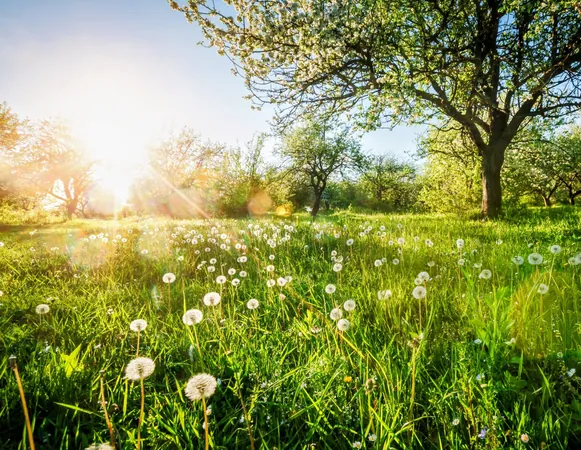
Nature’s Global Clock: How Short Distances Create Different Seasons
2025-09-05
Author: Li
Seasons Are Not Universal
Earth’s seasons are far from uniform. A groundbreaking global study has revealed that seasonal timing can vary dramatically, even across short distances, challenging the idea of a single, global seasonal clock.
Unlocking the Secrets of Plant Growth
Led by Drew E. Terasaki Hart from the University of California, Berkeley, researchers analyzed 20 years of satellite data to create a detailed map of plant growth cycles throughout the year. This innovative work focused on a field called phenology—the study of when plants bloom and rest.
Assessing Growth with Satellite Precision
Utilizing near-infrared reflectance of vegetation (NIRV) and solar-induced chlorophyll fluorescence (SIF), scientists gained accurate insights into plant energy capture and growth patterns. This data signals when plants are flourishing and when they pause, providing a comprehensive view of seasonal dynamics.
Diverse Seasons, Unexpected Locations
The analysis uncovered remarkable variations in seasonal timing in regions like the Mediterranean and tropical mountains, where geography and local weather patterns create distinct ecosystems. In the U.S. Southwest, cities just 100 miles apart can face drastically different seasonal rhythms due to varying rainfall patterns.
Impacts of Timing on Biodiversity
These variations in seasons are more than academic. They can lead to reduced genetic exchange among populations that breed at different times, an issue that could enhance biodiversity over long periods. For example, in Colombia, coffee growers adjust their harvest strategies to two distinct seasons influenced by local climate.
Mapping Change Through Satellite Technology
By analyzing extensive satellite records, researchers constructed models to identify rapid shifts in seasonal timing. Where these shifts are most pronounced, neighboring ecosystems can find themselves out of sync, affecting migration and feeding patterns of wildlife.
Consequences of Climate Change and Human Activity
As climate change shifts rainfall and temperature patterns, some species risk falling out of sync with their food sources. This also creates challenges in agriculture, where irrigation can lead to mismatched growth cycles. Understanding these discrepancies aids in more effective resource management.
The Bigger Picture: Evolution, Ecology, and Economy
Seasonal timing may be a subtle yet crucial change with vast implications. From ensuring young animals find food to enabling flowers to interact with pollinators, the shifting of seasons influences ecosystems and agriculture alike. This research underscores the need for preparedness in the face of evolving global climates.
The Conclusion: Seasons Matter Where You Are
Ultimately, while seasons are a constant feature of life on Earth, their timing is anything but predictable. This study highlights the importance of recognizing local seasonal variations and their wider impacts on biodiversity, agriculture, and ecological balance.



 Brasil (PT)
Brasil (PT)
 Canada (EN)
Canada (EN)
 Chile (ES)
Chile (ES)
 Česko (CS)
Česko (CS)
 대한민국 (KO)
대한민국 (KO)
 España (ES)
España (ES)
 France (FR)
France (FR)
 Hong Kong (EN)
Hong Kong (EN)
 Italia (IT)
Italia (IT)
 日本 (JA)
日本 (JA)
 Magyarország (HU)
Magyarország (HU)
 Norge (NO)
Norge (NO)
 Polska (PL)
Polska (PL)
 Schweiz (DE)
Schweiz (DE)
 Singapore (EN)
Singapore (EN)
 Sverige (SV)
Sverige (SV)
 Suomi (FI)
Suomi (FI)
 Türkiye (TR)
Türkiye (TR)
 الإمارات العربية المتحدة (AR)
الإمارات العربية المتحدة (AR)